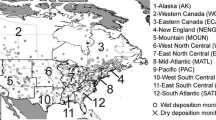Abstract
This paper presents one of the first integrated analyses of acidification and climate change on a geographically-detailed basis, and the first linkage of integrated models for acid deposition (RAINS) and for climate change (IMAGE 2). Emphasis in this paper is on Europe. Trends in driving forces of emissions are used to compute anthropogenic SO2 emissions in 13 world regions. These emissions are translated into regional patterns of sulfur deposition in Europe and global patterns of sulfate aerosols using source-receptor matrices. Changes in climate are then computed based on changes in sulfate and greenhouse gases. Finally, we compute ecosystem areas affected by acid deposition and climate change based on exceedances of critical loads and changes in potential vegetation. Using this framework, information from global and regional integrated models can be used to link sulfur emissions with both their global and regional consequences. Preliminary calculations indicate that the size of European area affected by climate change in 2100 (58%) will be about the same as that affected by acid deposition in 1990. By the mid 21st century, about 14% of Europe's area may be affected by both acid deposition and climate change. Also, reducing sulfur emissions in Europe will have both the desirable impact of reducing the area affected by acid deposition, and the undesirable impact of enhancing climate warming in Europe and thus increasing the area affected by climate change. However, for the scenarios in this paper, the desirable impact of reducing sulfur emissions greatly outweighs its undesirable impact.
Similar content being viewed by others
References
Alcamo, J., ApSimon, H., Builtjes, P. (Eds): 1987, Interregional Air Pollutant Transport: The Linearity Question, Research Report RR-87-20, International Institute for Applied Systems Analysis, Laxenburg, Austria.
Alcamo, J., Shaw, R., L. Hordijk (Eds): 1990, The RAINS Model of Acidification: Science and Strategies in Europe, Kluwer Academic Press, Dordrecht, Boston, 402 pp.
Alcamo, J. (Ed.): 1994a. IMAGE 2.0: Integrated Modeling of Global Climate Change. Kluwer Academic Press, Dordrecht, Boston, 314 pp.
Alcamo, J., G.J. van den Born, A.F. Bouwman, B.J. de Haan, K. Klein Goldewijk, O. Klepper, J. Krabrc, R. Leemans, J.G.J. Olivier, A.M.C. Toet, H.J.M. de Vries, H.J. van der Woerd. 1994b: Modeling the global society-biosphere-climate system: Part 2: Computed scenarios. Water, Air, Soil Pollution, 76, 37–78.
Carter, T.R., Parry, M.L., Harasawa, H., Nishioka, S.: 1994, IPCC Technical Guidelines for Assessing Climate Change Impacts and Adaptions, Working Group II of the Intergovernmental Panel on Climate Change, CGER 1015–94.
Charlson, R.J., Schwartz, S.E., Haies, J.M., Cess, R.D., Coakley, J.A. Jr., Hansen, J.E., Hofman, D.J.:1992, Climate forcing by anthropogenic aerosols, Science 255, 423–430.
Cubasch, U., Hasselmann, K., Hock, H., Maier-Reimer, E., Mikolajewicz, U., Santer, B.D., Sausen, R.: 1992, Time-dependent greenhouse warming computations with a coupled ocean-atmosphere model, Climate Dynamics, 8, 55–69.
Downing, R.J., Hettelingh, J.-P., de Smet, P.A.M. (Eds): 1993, Calculation and Mapping of Critical Loads in Europe, CCE Status Report, RIVM, Bilthoven, The Netherlands, 163 pp.
ECE (U.N. Economic Commission for Europe): 1994, Protocol to the 1979 Convention on Long-Range Transboundary Air Pollution on Further Reduction of Sulfur Emissions. ECE/EB.AIR/40. United Nations, New York and Geneva, 106 pp.
de Haan, B.J., M. Jonas, O. Klepper, J. Krabec, M.S. Krol, K. Olendrzynski: 1994, An atmosphere-ocean model for integrated assessment of global change. Water, Air, Soil Pollution, 76(1–2): 283–318.
IPCC (Intergovernmental Panel on Climate Change): 1995, Climate change 1994, Houghton, J.T., Meira Filho, L.G., Bruce, J., Hoesung Lee, Callander, B.A., Haites, E., Harris, N, Maskell, K. (Eds.), Cambridge University Press, 339 pp.
Jonas, P.R., Charlson, R.J., Rodhe, H.: 1995, Aerosols, in: IPCC, Climate Change 1994, Cambridge University Press, pp. 127–162.
Langner, J., Rodhe, H,:1991, A global three-dimensional model of the tropospheric sulfur cycle, J. Atmos. Chem., 13, 225–263.
Leggett, J., W.J. Pepper and R.J. Swart. 1992: Emission Scenarios for the IPCC: an Update. In: IPCC, Climate Change 1992: The Supplementary Report to the IPCC Scientific Assessment. Cambridge University Press, Cambridge.
Leemans, R., van den Bom, G.J.: 1994, Determining the potential global distribution of natural vegetation, crops, and agricultural productivity, Water, Air, Soil Pollution, 76, 133–163.
Leemans, R., Cramer, W.: 1991, The IIASA database for mean monthly values of temperature, precipitation and cloudiness on a global terrestrial grid. IIASA Research Report RR 91-18, International Institute of Applied Systems Analysis, Laxenburg, Austria, 61pp.
Manabe, S., Stouffer, R.J., Spelman, M.J., Bryan, K.: 1991, Transient response of a coupled ocean-atmosphere model to gradual changes of atmospheric CO2. Part 1: Annual mean response, J. of Climate, 4, 785–818.
Nilsson, J. and Grennfelt, P. (Eds): 1988, Critical Loads for Sulphur and Nitrogen, Nord 1988:97, Nordic Council of Ministers, Copenhagen, Denmark, 418 pp.
Prentice, I.C., Cramer, W., Harrison, S.P., Leemans, R., Monserud, R.A., Solomon, A. 1992. A global biome model based on plant physiology and dominance, soil properties, and climate. Journal of Biogeography. 19: 117–134.
Roemer, M.G.M.: 1991, Ozone and the greenhouse effect, IMW-TNO report R 91/227, Delft, the Netherlands.
Taylor, K.E., Penner, J.E.: 1994, Response of the climate to atmopsheric aerosols and greenhouse gases, Nature, 369: 734–737.
Tuovinen, J.-P., Barrett, K. and Styve, H.: 1994, Transboundary Acidifying Pollution: Calculated Fields and Budgets 1985–93, EMEP/MSC-W Report 1/94, Norwegian Meteorological Institute, Oslo, Norway
de Vries, H.J.M., J.G.J. Olivier, R.A. van den Wijngaart, G.J.J. Kreileman, and A.M.C. Toet: 1994, A model for calculating regional energy use, industrial production and greenhouse gas emissions for evaluating global climate scenarios. Water, Air, Soil Pollution, 76(1–2): 79–132.
Author information
Authors and Affiliations
Rights and permissions
About this article
Cite this article
Alcamo, J., Krol, M. & Posch, M. An integrated analysis of sulfur emissions, acid deposition and climate change. Water Air Soil Pollut 85, 1539–1550 (1995). https://doi.org/10.1007/BF00477200
Issue Date:
DOI: https://doi.org/10.1007/BF00477200




